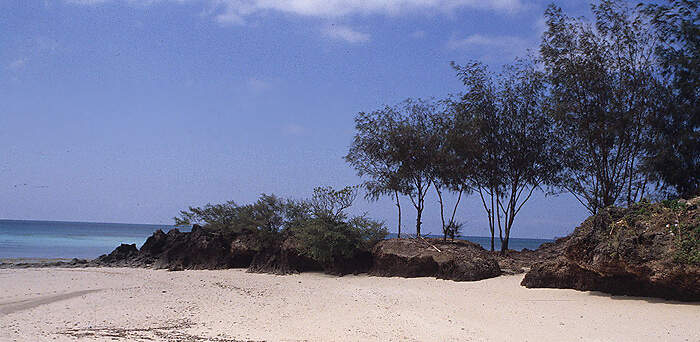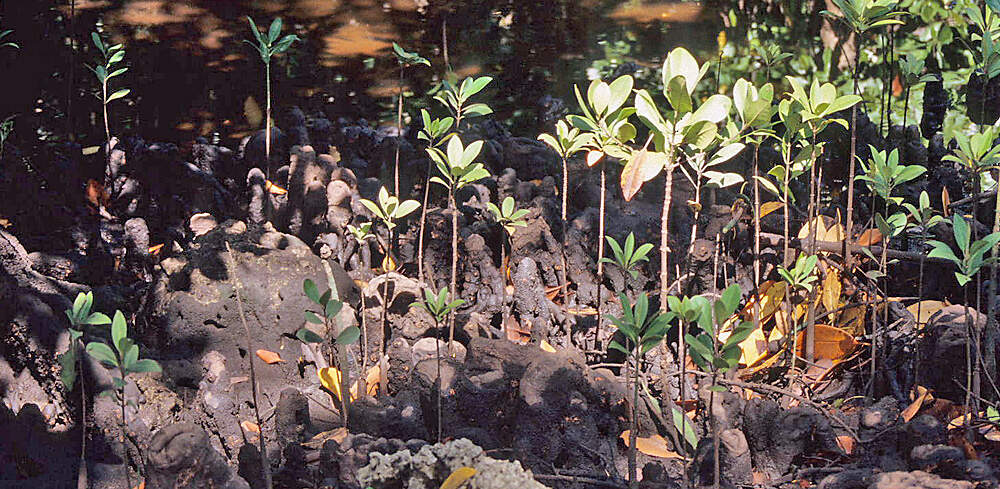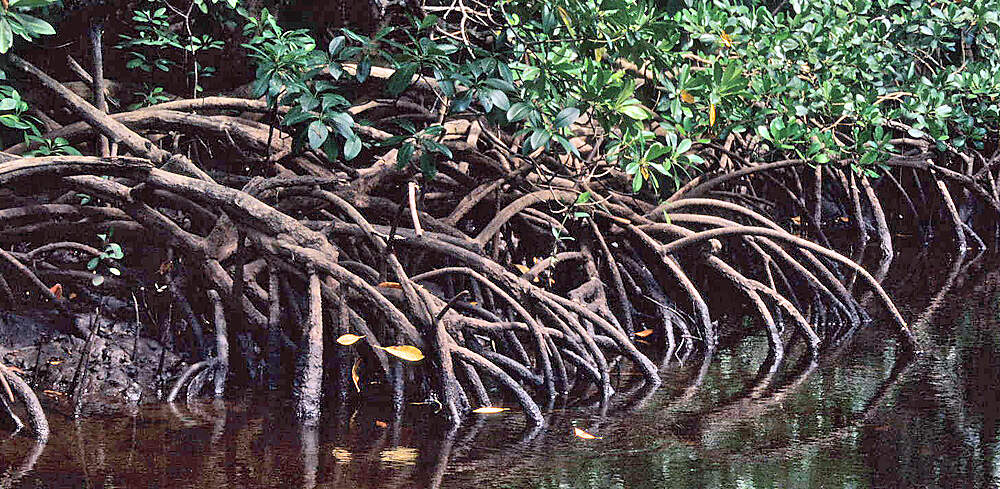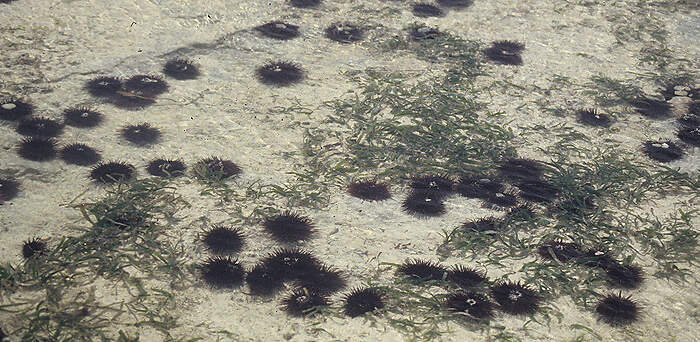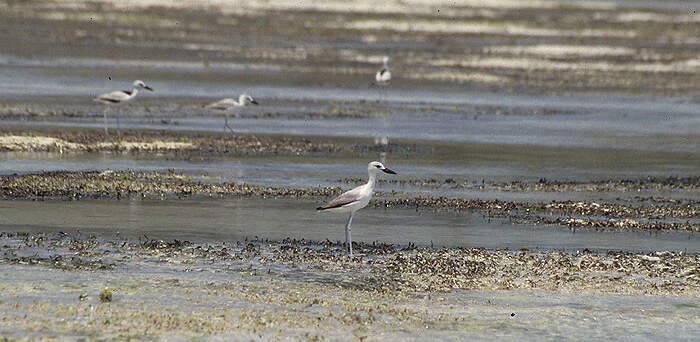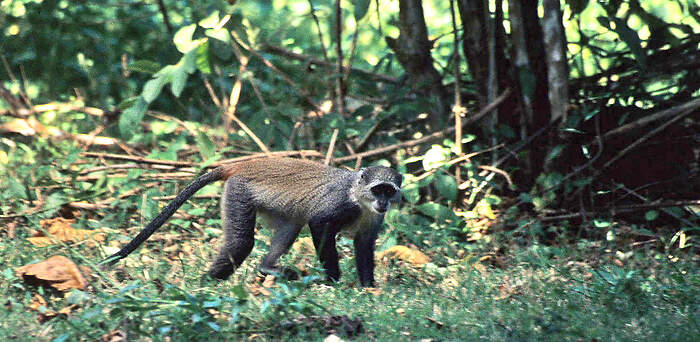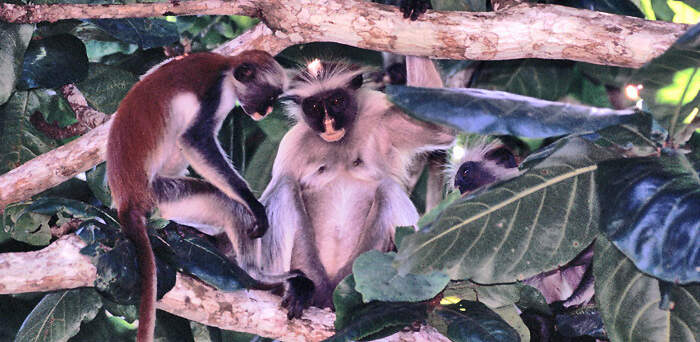BAREJ, M. F., SCHMITZ, A., MENEGON, M., HILLERS, A., HINKEL, H., BÖHME, W. & RÖDEL, M. (2011)
Dusted off - The African Amietophrynus superciliaris-species complex of giant toads.
Zootaxa 2772: 1–32 (2011). www.mapress.com/zootaxa
Abstract:
Amietophrynus superciliaris is known to occur in rain forests from West Africa to eastern Democratic Republic of Congo and Gabon. We herein present morphological and molecular data indicating the existence of three distinct taxa. The name A. superciliaris superciliaris is restricted to toads from the western Lower Guinean Forest (eastern Nigeria, Cameroon, Equatorial Guinea, Gabon). We resurrect A. s. chevalieri for the Upper Guinean forest (Sierra Leone, Guinea, Liberia, Ivo-ry Coast, Ghana) and describe a new species occurring in the eastern part of the Lower Guinean Forest (eastern Demo-cratic Republic of Congo). Amietophrynus channingi sp. nov. from eastern Lower Guinean Forest differs from both other taxa by its brownish lateral coloration (reddish-purple in the other taxa). The new species differs morphologically from western Lower Guinean A. s. superciliaris by a less pointed eyelid process, a dark coloured posterior abdominal region and a dark coloured vertebral line (both absent in A. s. superciliaris), the shape of the parotid glands (bulged and rounded at the posterior tip in the new species, slender drop shaped and pointed at the posterior tip in A. s. superciliaris), and ju-venile interorbital markings (V-shaped in the new species, usually interrupted and broken in A. s. superciliaris). Amietophrynus channingi sp. nov. differs from the Upper Guinean A. s. chevalieri by the presence of an eyelid process (absent in A. s. chevalieri), presence of a dark vertebral line and a pair of dark spots on the posterior part of the back (both absent in A. s. chevalieri). The Upper Guinean A. s. chevalieri differs from western Lower Guinean A. s. superciliaris by the absence of an eyelid process, a dark coloured posterior abdominal region (absent in A. s. superciliaris) and lacking a pair of dark spots in the posterior part of the back (present in A. s. superciliaris). The new species differs from both other taxa by 2.2–2.8% in the investigated 16S rRNA gene. West African and western Central African populations differ by only 0.9–1.1% in 16S rRNA, lacking any intra-taxon variation within each clade, and are cautiously regarded as subspecies although the genetic distinction is mirrored by strong morphological differences and distinct geographic distribution which may support its elevation to species status once that more comprehensive data become available. A key to the taxa of the A. superciliaris-species complex is provided.
Dusted off - The African Amietophrynus superciliaris-species complex of giant toads (PDF Download Available). Available from: https://www.researchgate.net/publication/230555620_Dusted_off_-_The_African_Amietophrynus_superciliaris-species_complex_of_giant_toads [accessed Dec 06 2017].
BOULENGER, G. A. (1888)
List of the reptiles and batrachians collected by Mr. H. H. Johnston on the Rio del Rey, Cameroons District, W. Africa.
Proceedings of the Zoological Society of London 1887: 564–565.
Volltext
OHLER, A. & DUBOIS, A. (2016)
The identity of the South African toad Sclerophrys capensis Tschudi, 1838 (Amphibia, Anura).
PeerJ 4(e1553): 1–13.
Abstract:
The toad species Sclerophrys capensis Tschudi, 1838 was erected for a single specimen from South Africa which has never been properly studied and allocated to a known species. A morphometrical and morphological analysis of this specimen and its comparison with 75 toad specimens referred to five South African toad species allowed to allocate this specimen to the species currently known as Amietophrynus rangeri. In consequence, the nomen Sclerophrys must replace Amietophrynus as the valid nomen of the genus, and capensis as the valid nomen of the species. This work stresses the usefulness of natural history collections for solving taxonomic and nomenclatural problems.
WAGNER, P. BÖHME, W., PAUWELS, O.S.G & SCHMITZ, A (2009)
A review of the African red–flanked skinks of the Lygosoma fernandi (BURTON, 1836) species group (Squamata: Scincidae) and the role of climate change in their speciation.
Zootaxa 2050: 1–30. ISSN 1175-5326.
Abstract:
We present an analysis of the morphometric and genetic variability of Lygosoma fernandi. Geographical variation and taxonomic consequences are discussed and Lepidothyris Cope, 1892 is resurrected as genus for the L. fernandi species group. The results show that Lepidothyris fernandi sensu lato is a species complex, which comprises an eastern and a western species. Each of them has a further subspecies of its own, and a third distinct species is present in southwestern Central Africa. The morphological and genetic differences between these taxa are analyzed resulting in the description of two new taxa, and the resurrection of two more taxa.
FERGUSSON, R. A. (2010)
Nile Crocodile - Crocodylus niloticus.
In: Crocodiles.Status Survey and Conservation Action Plan: 84-89.
Third Edition, ed. by S.C. Manolis and C. Stevenson. Crocodile Specialist Group: Darwin.
Aus dem Inhalt:
More than 750 surveys using a variety of methods have been carried out for C. niloticus since the 1950s. Despite covering 315 different locations only 8 of these have been surveyed enough to allow estimation of population trends. All of these are located in southern and East Africa where there have been significant recent improvements in monitoring. In central and West Africa the availability of survey data is very poor. Overall, survey data are insufficient or non-existent in 25 of 42 Range States. The need for wild population recovery and/or conservation is moderate throughout much of east and southern Africa with recent detailed studies suggesting an urgent need for conservation action in specific areas, but is high in central and West Africa. Many populations are believed to have recovered by the 1990s but are now constrained or in decline due to anthropogenic factors.
SHIRLEY, M. H. (2010)
Slender-snouted Crocodile - Crocodylus cataphractus.
In: Crocodiles.Status Survey and Conservation Action Plan: 54-58.
Third Edition, ed. by S.C. Manolis and C. Stevenson. Crocodile Specialist Group: Darwin.
Aus dem Inhalt:
Historically, C. cataphractus was widely distributed throughout West and Central Africa, but recent surveys suggest that its distribution has changed as a result of local extirpations. While relatively little is known about the ecology of the species, it appears to prefer forested rivers and other densely vegetated bodies of water (i.e. reservoirs and freshwater lagoons), but has also been found in sparsely vegetated, gallery habitats within savannah woodland.
LUISELLI, L. & DIAGNE, T. (2009)
Kinixys erosa (Schweigger 1812) – Forest Hinge-back Tortoise, Serrated Hinge-back Tortoise, Serrated Hinged Tortoise.
In: Rhodin, A.G.J., Pritchard, P.C.H., van Dijk, P.P., Saumure, R.A., Buhlmann, K.A., Iverson, J.B., and Mittermeier, R.A. (Eds.). Conservation Biology of Freshwater Turtles and Tortoises: A Compilation Project of the IUCN/SSC Tortoise and Freshwater Turtle Specialist Group. Chelonian Research Monographs 5(7):084.1–13, doi:10.3854/crm.5.084.erosa.v1.2014, http://www.iucn-tftsg.org/cbftt/.
Summary:
The Forest Hinge-back Tortoise, Kinixys erosa (Family Testudinidae), is a forest tortoise with considerable range over the continuous Guinea–Congo rainforest region in West and Central Africa. It is a medium-sized to large tortoise, with a carapace length reaching ca. 400 mm, and males larger than females. Tortoises of the genus Kinixys can close themselves entirely within their shells through a unique posterior carapacial hinge. Kinixys erosa inhabits the lowland evergreen forest, marshy areas, and forest galleries growing along rivers and streams, where it is locally threatened by clearance of forest for cultivation and hunting pressure. It has an omnivorous diet, with mushrooms being predominant. Population sizes are strongly depressed in areas where these tortoises are actively hunted by human populations. The main threats for this species include subsistence hunting by local people in desperately poor economic conditions, agricultural and industrial expansion with deforestation, and trade for the pet industry. There is a strong need for more field research on K. erosa ecology, abundance, and status. There are no known conservation actions for this species; however, there is a need to establish protected areas that include viable populations of these tortoises through their natural range.
Distribution. – Angola, Benin, Cameroon, Central African Republic, Congo (Democratic Republic of Congo–DRC), Congo (Republic of Congo–ROC), Equatorial Guinea, Gabon, Ghana, Guinea, Ivory Coast (Côte d’Ivoire), Liberia, Nigeria, Sierra Leone, Togo, Uganda. Widely distributed along coastal forested West Africa from Sierra Leone and Guinea through the Congo Basin of central Africa to northern Angola.
Synonymy. – Testudo erosa Schweigger 1812, Kinixys erosa, Cinixys erosa, Kinixys belliana erosa, Testudo schoepfii Fitzinger 1826 (nomen nudum), Kinixys castanea Bell 1827, Cinixys (Cinixys) castanea, Cinixys castanea.
Subspecies. – None recognized.
Status. – IUCN 2014 Red List: Data Deficient (DD, assessed 1996); TFTSG Draft Red List: Endangered (EN, assessed 2013); CITES: Appendix II, as Testudinidae spp.
HOFMEYR, M. D. (2009)
Chersina angulata (Schweigger 1812) – Angulate Tortoise, South African Bowsprit Tortoise.
In: Rhodin, A.G.J., Pritchard, P.C.H., van Dijk, P.P., Saumure, R.A., Buhlmann, K.A., Iverson, J.B., and Mittermeier, R.A. (Eds.). Conservation Biology of Freshwater Turtles and Tortoises: A Compilation Project of the IUCN/SSC Tortoise and Freshwater Turtle Specialist Group. Chelonian Research Monographs No. 5, pp. 030.1-030.6, doi:10.3854/crm.5.030.angulata.v1.2009, http://www.iucn-tftsg.org/cbftt/.
Summary:
The angulate or bowsprit tortoise, Chersina angulata (Family Testudinidae), is endemic to southern Africa and is the type species of the monotypic genus. No subspecies are distinguished, but mtDNA markers indicate the presence of two distinct evolutionary lineages associated with the southern and western regions of South Africa, respectively. The species is medium-sized (carapace length to ca. 350 mm), sexually dimorphic with males larger than females, characterized by a large, protruding, undivided gular scute, and displays substantial color and size variation.
The species is active throughout the year but temperature and rainfall modify its activity patterns. Males appear to establish dominance hierarchies in spring when they use their large gular scute to overturn rival conspecific males. Females produce single-egg clutches from late summer to late
spring and can lay up to six clutches annually. Egg retention time varies substantially and correlates with temperature and rainfall. The diet includes a wide range of angiosperms as well as mosses, mushrooms, insects, snails, and animal feces. They are selective feeders and their diet changes with season and site.
Chersina angulata is not threatened and is adequately protected.
Distribution. – Namibia, South Africa. The range extends along the southern and western regions of South Africa into southwestern Namibia.
Synonymy. – Testudo angulata Schweigger 1812, Testudo (Chersina) angulata, Chersina angulata, Goniochersus angulata, Neotestudo angulata, Chersine angulata, Testudo bellii Gray 1828, Chersina angulata pallida Gray 1831
Subspecies. – No subspecies currently recognized.
Status. – IUCN 2008 Red List: Not Listed (= Least Concern, LR/lc) (assessed 1996, needs updating); CITES: Appendix II (as Testudinidae spp.); South African Red Data Book: Not Listed.
NYOKA, B. I. et al. (2011)
The State of the World's Forest Genetic Resources - Country Report Zimbabwe 2002-2011.
82 Seiten.
Ministry of Environment and Natural Resources Management, Republic of Zimbabwe. © Forestry Commission, ISBN 0-7974-5000-4.
Executive Summary:
The Ecosystem Land Classification Approach adopted by the Convention on Biological Diversity (CBD) divides Zimbabwe into five eco-regions: the Kalahari, 46,891 km² (12%); Central, 195,379 km² (50%); Zambezi, 62,521 km² (16%); Save-Limpopo, 78,151 km² (20 %) and the eastern highlands covering 7,815 km² (2%) of the total land area.
Indigenous forests
The natural forest ecosystem is classified into Flora Zambesiaca and Afromontane phyto region. The Flora Zambesiaca comprises five woodlands types: dry Miombo (17,690,074ha), Mopane (12,277,515ha), Combretum-Terminalia (2,374,729ha), Acacia (1,581,070ha) and Zambezi teak (1,404,544ha). The main commercial timber species are Baikiaea plurijuga and Pterocarpus angolensis found in the Zambezi teak woodlands. The Afromontane phyto region covers 781,500ha.
Exotic Forest Plantations
The forest plantations are found in the eastern part of the country where rainfall is high enough to sustain tree growth and productivity. There are also smaller plantations of eucalypts in the central part of the country (Mvuma, Norton and Marondera, Eagle’s nest). The plantation forests (155,000ha) account for 0.4% of the land area. The plantations are all of exotic species of pines, eucalypts and the black wattle (Acacia mearnsii). The exotic plantations provide timber, poles, pulp and paper, tannin and furniture. The success of the plantation industry is largely linked to the genetic improvement programme of exotic timber species that began in 1958. Dozens of exotic tropical and sub-tropical Pinus spp. were introduced and tested for adaptation, growth and timber qualities. Zimbabwe has a very simple but effective advanced generation breeding programme of Pinus patula, P. taeda, P. elliottii and P. kesiya, Eucalyptus grandis, Eucalyptus tererticornis and E. camaldulensis that produce and markets high quality tree seed locally, regionally and internationally. There are over 3,100 Plus trees that were selected in all the exotic species.
Contribution of the forestry sector
The commercial forestry industry based on exotic trees contributes about 4% to the Gross Domestic Product. The commercial plantation based industry employed an average of 14,600 people between the period 2005 and 2010. However there was a general decline in the industry as shown by a significant decline of 29% between 2009 and 2010. The production of paper and paper products declined between 2005 and 2009. In 2002, exports of forestry products were US$20 million and increased to over US$30 million in 2010.
The indigenous hardwood industry based on B. plurijuga and P. angolensis employs an additional 2,000 people and a significant number in the downstream furniture industry. Commercial harvesting of hardwoods has declined over the years from 44,000m3 in 1990, to 22,000 in 1996 and 20,000m3 in 2002 mainly due to raw material shortages as a result of over-harvesting in the past decades. Other than the commercial timber industry, the contribution of the forests to the national economy is grossly under-estimated as reliable statistics are not available for both the environmental services and the informal sector. It is estimated that firewood provides over 80% of the energy used by rural households and 40% of the urban population. Other than fuelwood, forests provide fruits, mushrooms, honey, bush meat, edible caterpillars and insects, vegetables, medicines, poles, bark string and browse for livestock and wildlife. Over 78% of the rural households in Zimbabwe use herbal medicines at least once in a year for both humans and livestock.
Forests protect important watersheds which support large irrigation dams in the country as well as many water courses. Forests also provide habitats for wildlife which is the major basis for the country’s tourism industry, the third highest foreign currency earner after agriculture and mining. There is a need for the country to develop reliable methods to capture all these contributions to better understand the role.
Protection of forests
Cumulatively, over 867,000ha of forest land were burnt by fire in the protected forests between 2004 and 2010. In 2010 alone, over 79,000ha of protected indigenous forests were burnt by fire. In the forest plantations, a cumulative 32,000ha of plantation area was burnt between 2005 and 2010. In one single year (2009), almost 20% of the exotic plantation area was burnt by fires. There is a need for the country to urgently strengthen the capacity of the forest authorities to enable them to control wild fires that evidently, have had a huge impact on both the economy and forest resources.
Changes in forest cover
The latest statistics available (2008) indicate that woodlands have declined from 53.2% to 42.3%; bushland from 12.7% to 10.8%; wooded grasslands from 3.1% to 2.3% and grasslands from 1.8% to 1.2%. The natural moist forest has not changed and remains at 0.03% while the exotic plantations marginally increased from 0.40% to 0.43%. The area under cultivation increased from 27.5% to 41.2%. More than 330,000ha of land are now being lost to agriculture (crops) annually compared to 70,000ha per year prior to this upsurge. Unless this is translated into increased agricultural output from the converted land, it will represent a huge loss nationally.
Invasive woody species
The new environmental law (Environmental Management Act) recognises the threat posed by invasive trees and other woody species. The major invasive species include Lantana camara, Pinus patula, Populus canescens, Acacia mearnsii, Jacaranda mimosifolia and Psidium spp. The priority must now be to quantify the extent of the invasion in all areas by species, develop control strategies, estimate the cost of controlling the invasions, determine the environmental costs, to ensure that progress on control is quantified and monitored.
In situ and Ex situ Conservation of forest genetic resources
Zimbabwe uses multiple strategies to conserve forest genetic resources. In situ conservation in the country’s formally protected areas (protected forests and parks wildlife areas) add up to 49,700 km² while a further 56,135 km² is protected under the CAMPFIRE. There are also sacred trees, forests and landscapes whose protection is mostly cultural. The exact number of sacred forests and woodlands and their extent in Zimbabwe is however not known. The National Herbarium and Botanic Garden in Harare and its outstation in Mazowe (Mazowe Botanical Reserve) have built a comprehensive collection of plants found in Zimbabwe and the southern African region totalling 1,060 plant species, representing 82% of the 1,230 woody species found in Zimbabwe.
The Nationals Parks and Wildlife Management Authority manages ex situ forest genetic resources through two botanic gardens, Ewanrigg near Shamva (area of 286 ha) and Vumba, near Mutare, (area of 242 ha). Exotic industrial tree species are mostly conserved as seed (23,000 accessions) and in arboreta and clone banks. There are more than 3,100 Plus trees being conserved.
Legislation and Policies on Forest Genetic Resources
The management of forest resources in Zimbabwe is still dualised; the Forest Act regulates the use of forest resources on state and private land, and the Communal Lands Forest Produce Act (CLFPA) governs the use of forestry resources in communal areas. The Forest Act mandates the Forestry Commission to manage forest genetic resources in the country and regulate its activities specifically on protected forests (state forests) and forests on private land while the CLFPA gives local communities limited rights to exploit the forest resources in their area for subsistence use only. The Parks and Wildlife Act provides for the protection of six types of areas: national parks, safari areas, sanctuaries, botanical gardens, botanical reserves and ecreational parks, each with a specific objective. The Environmental Management Act provides for the conservation of and access to biological diversity and the regulation of biological and genetic resources. The other pieces of legislation with relevance to the management of forest genetic resources in Zimbabwe include: Traditional Leaders Act, Seeds Act and Plant Pests and Diseases Act. National policies and action plans that relate to the management, conservation and utilisation forest genetic resources in Zimbabwe are the National Environment Policy (NEP), Forest Based Land Reform Policy (FBLRP) and Zimbabwe National Biodiversity Strategy and Action Plan (NBSAP).
Threatened Trees and shrubs
A number of trees and shrubs are listed as endangered or threatened. Most of the endangered or threatened woody species are either endemic or have a very restricted distribution in Zimbabwe. The species include Warbugia salutaris, Swynnertonia cardinea, Combretum umbricola, Combretum coriifolium, Juniperus procera, Bivinia jalbertii, Homalium abdessammadii, Scolopia mundii, Cassia afrofistula, Ficus bubu, Ficus fischeri, Ficus ottoniifolia subsp. ulugurensis, Milicia excelsa, Morus mesozygia, Streblus usambarensis and Turraea eylesii. The challenge now is to reverse the decline in the populations and number of the trees of these species.
Important tree species
There are both indigenous and exotic tree species that are important in Zimbabwe for timber, poles, fodder, gum Arabic, fruit and medicinal. They include exotic timber species (Pinus patula, P. taeda, P. elliottii and P. tecunumanii), exotic species for poles (Eucalyptus grandis, E. tereticornis and E. camaldulensis), furniture (Baikiaea plurijuga, Pterocarpus angolensis and Afzelia quanzensis), indigenous fodder tree species (Faidherbia albida and Acacia erioloba), medicinal (Warbugia salutaris), gum Arabic (Acacia karroo) and indigenous fruit tree species (Uapaca kirkina, Strychnos cocculoides, Adansonia digitata, Sclerocarya birrea and Vangueria infausta). Some of these important species have active breeding programmes while others are in conservation programmes.
Education and Training
There are now several state and quasi-state colleges and universities in Zimbabwe that offer training from Diploma to MSc level in general forestry, forestry and wildlife management, wildlife and rangeland management, natural resource management, agroforestry and tropical resources ecology. Two colleges: Zimbabwe College of Forestry and Mushandike Natural Resources College offer training at Diploma level in forestry and natural resources management respectively; Bindura University offers training up to MSc in forestry; the National University of Science and Technology, Midlands State University, Chinhoyi University of Technology and Africa University offer training at BSc level in natural resources. The Institute for Environmental Studies of the University of Zimbabwe offers an MSc programme on tropical ecology and resources. No university however offers training in specialist areas such as forest genetics and conservation.
Research
The main forestry research projects are on breeding of industrial exotic tree species. There is also limited research on breeding of non-industrial exotic and indigenous tree species. Besides their usual teaching activities, some universities have also complemented the Forestry Commission in conducting research particularly on the management of indigenous forests. There have been collaborative projects involving international research organisations (ICRAF, CIFOR and IPGRI) but these were mostly scaled down during the hyperinflationary period. A number of NGOs (SAFIRE and CTDT) have been carrying out research on value addition (processing of wild fruits) and other non-wood forest products.
Future Needs and Priorities
- Due to economic challenges in the past decade, some of the planned activities on conservation of forest genetic resources were scaled down. The stabilisation of the economy presents opportunities to revisit some of the planned activities. In future therefore:
- There will be a need to conduct expeditions to verify the existence or disappearance of some of the tree species that have been reported as extinct or critically endangered.
- There will be a need to map the important sacred forests and determine their number, location and size as well as their floristic composition.
- There is a need to conduct comprehensive genetic studies (molecular and quantitative) on the endangered tree species and develop optimum conservation strategies for them.
- The research and development in forest trees in Zimbabwe has remained basic, relying on what may now be inefficient approaches. There is a need to use modern methods that are fast, efficient and more reliable and perhaps cost effective in the long run.
- On invasive woody species, the priority must be to quantify the extent of the invasion in all areas; the cost in terms of control and lost environmental services to ensure that progress on control is quantified and monitored.
- In the short term there will be a need to prioritise ex situ conservation of the trees species listed on the National Red Data List. Efforts must be placed on both the protection of the remaining trees and stands as well as artificially aiding their reproduction.
- There will be an urgent need for the relevant institutions to initiate the re-introduction into natural habitats of species that now only exist in the home gardens.
- There is a need to review forest policies and laws to align them with current land ownership as well as global trends on ABS. In view of the concluded land reform, there is a need to review the applicability of the present laws to the new land ownership system.
- Zimbabwe does not as yet have any programmes and projects exploring Carbon trade. This is an area that can potentially strengthen the conservation of forest genetic resources.
- Restoration of the membership of the Forestry Commission to major cooperatives and networks (CAMCORE, SAFORGEN, IUFRO, etc) should be a major priority. This is expected to enable Zimbabwe to not only access germplasm but also allow local scientists to engage with their peers in international fora.
nyoka-biblio
Inseln vor der Ostafrikanischen Küste
Unmittelbar vor der ostafrikanischen Küste liegen vier Inselgruppen: der Lamu-Archipel vor Kenia, der Sansibar-Archipel vor Tansania sowie der Quirimbas Archipel und der Basaruto-Archipel vor Mosambik.
Sansibar
|
|
AllgemeinesDer Sansibar-Archipel besteht aus der Hauptinsel Sansibar (Unguja), Pemba und Mafia mit ihren Nebeninseln, darunter das Atoll Mnemba, sowie die Koralleninsel Latham, die von einem Saumriff umgeben ist. Alle Inseln zusammen haben eine Fläche von etwa 3'200 km². Mit über 370 Einwohnern / km² ist der Archipel äußerst dicht besiedelt. Die Inseln sind ziemlich flach, die höchste Erhebung liegt 120 m.ü.M. Während der letzten Eiszeit waren sie mit dem Festland verbunden, was in der Säugetierfauna zum Ausdruck kommt. Sansibar ist Teil des Brennpunkts der Biodiversität "Ostafrikanische Gebirge und Küstenwälder". In den rund 1400 km² Küstenwald auf dem Festland und den Inseln kommen rund 600 endemische Pflanzen und 300 endemische Arten Land-Wirbeltiere vor, darunter Roter Sansibar-Stummelaffe (Procolobus kirkii), Sansibar-Galago (Galagoides), Sansibar-Ginsterkatze (Genetta servalina archeri), Aders-Ducker (Cephalophus adersi) und Pemba-Flughund (Pteropus voeltzkowi), ferner der Sansibar-Fiederbartwels (Synodontis zanzibaricus). Vegetation und CharakterpflanzenGroße Teile des Küstenwaldes Tansanias sind zwar nicht eigentliche Schutzgebiete, stehen aber unter dem Schutz der Forstgesetzgebung. Allerdings ist der Wald stark fragmentiert und besteht heute aus 165 einzelnen Wäldern, die im Mittel nur 850 ha umfassen. Charakteristische Baumarten sind Rosenholz (Calophyllum inophyllum), Schraubenbaum (Pandanus rabaiensis), Ölpalme (Elaeis guineensis). Den Mangrovenwald dominieren Rhizophora mucronata, Ceriops tagal und Avicennia marina. TierweltWegen der dichten Besiedlung und der starken Fragmentierung der Wälder können sich Populationen größerer Säugetiere kaum halten. So ist der Sansibar-Leopard vermutlich seit 1996 ausgestorben (Rote Liste der IUCN). Zwerggalago (Galago senegalensis zanzibaricus), Roter Sansibar-Stummelaffe, Sansibar-Diademmeerkatze (Cercopithecus mitis albogularis), Sansibar-Ginsterkatze, Sansibar-Ducker, sämtliche waldbewohnenden Vogelarten der Insel (IBA TZ057, 556 ha), wo insgesamt 217 Arten vorkommen, darunter Braunkopfpapagei (Poicephalus cryptoxanthus), Sansibarspecht (Mesopicos elliotii johnstoni), Sansibarwürger (Laniarius sublacteus), Blauflügelrötel (Sheppardia gunningi) und Brandweber (Euplectes nigroventris). Nationalparks und SchutzgebieteJozani Chwaka Bay National ParkAuf der Hauptinsel gibt es nur einen Nationalpark, in dem der Josaniwald liegt. Der Park mit einer Fläche von 50 km² liegt nur wenige Meter über Seehöhe. Es erhält ca. 850 mm Niederschlag / Jahr, die mittlere Monatstemperaturen beträgt tagsüber 28-32°C, nachts 18-23°C. Der Josani-Nationalpark umfasst einen noch recht ursprünglichen Grundwasserwald, Küstenwald, Mangroven, Buschland und Salzwiesen. Es sind so ziemlich die einzigen Überbleibsel dieser Pflanzengesellschaften, die einst ganz Sansibar bedeckten. Die Chwaka-Bucht ist ein Important Bird Area (TZ045), vor allem für Reiherläufer (Dromas ardeola), Wüstenregenpfeifer (Charadrius leschenaultii) und Orientseeschwalbe (Sterna saundersi). Mafia Island Marine Park1995 wurde der Mafia Island Marine Park ausgerufen, der mit einer Fläche von 821 km² hauptsächlich dem Schutz der Korallenriffe und mehr als 400 Fischarten dient. |
![]()
Literatur und Internetquellen
BIRDLIFE DATA ZONE
EICHLER, D. (1997)
KING, D. (1996)
MITTERMEIER, R.A., MYERS, N. & GOETTSCH-MITTERMEIER, C. (1999)
Zurück zu Übersicht Meere, Inseln, Antarktis
Weiter zu Madagaskar

